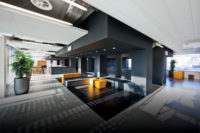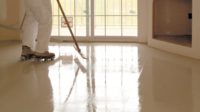Forever, people who live close to one another have suffered from the noises of their neighbors. In litigation, the second highest level of complaints comes from noise—the first is uninvited water. So, what’s the biggest complaint about noise?
Footfall from the neighbor above draws the most complaints. Next, would be party wall noise and depending on the environment, dogs or trains.
The longtime solution in design has come from two components—sound mat and resilient channels. Both are now specified in almost every apartment or condo built in North America. In today’s day and age, every conceivable assembly type has been tested to show compliance with building codes including: nominal lumber joists, open web joists, TJI and metal systems.
These assemblies perform better than the 1980’s assemblies. In the ’90s building codes established rigid criteria for what’s acceptable. Airborne noise and structural noise were designated under ASTM standards for sound transmission classification and impact insulation classification, respectively. The ASTM provided for a single number designation for how well the system performed and the building codes adopted the number 50 as the point of success. The scale was not linear, so as the number increased, the performance logarithmically increased by a constant multiple, making improvements harder to achieve and the cost of “luxury” difficult to justify.
The tests measure noise over a broad range of frequencies from high to low. That means if a floor or wall performs poorly at either, achieving an acceptable number is difficult. A code achieving 50 doesn’t mean all is quiet, by the way. Achieving code means it passes building inspection. Many acoustical professionals suggest luxury is in the mid-60s and studies indicate that performance range drastically drops the number of complaints.
What’s the Bother?
The answer is no complaints and achieving long-term renters. Even with the innovations of sound mats and resilient channels, expectations of more discerning residents are still not being met, as the complaints emanating from the low frequency thuds still abound. People move out when the building is noisy. People stay when the environment is quiet. So, here’s how to achieve quiet: sound mats, resilient channels and washers on steroids.
What’s a resilient channel? Most people describe it as a half a hat channel. What’s a “washer on steroids”? It is a rubber grommet isolation clip that has a long metal bracket that separately connects a resilient channel to the washer and positions the fastening point much farther away from the gypsum board ceiling.
A new solution is available that takes the performance of a resilient channel, the key component to low frequency footfall noise control, and logarithmically enhances its performance. The “washer” is more than a washer. The washer creates a circuitous path for low frequency waves and changes the floor ceiling performance with resilient channels from code compliant to luxury. That’s right, this new isolation methodology makes for IIC and STC performance in the 60s. That, by any acoustical expert, is luxury living.
Resilient channels have always been a part of the solution and the industry did adopt a belief that specific brands of channels performed better than others. It was difficult to understand why, but for the past decade, one brand of channels has been the most specified. The original brand developed in the 1960s was the solution of choice. The industry has made this channel’s demand quite high but the Steroidal Washer solution equalizes them. That means a significant portion of the added washer cost is absorbed by being able to specify any resilient channel.
There is also the added benefit that the Washer solution eliminates the most common installation error with resilient channels—short circuits. Short-circuits can occur when drywall screws penetrate through the resilient channel and into the framing member, effectively connecting the resilient channel to the framing members. Short-circuits severely limit the vibration (noise) reduction provided by the resilient channel.
Add Sound Mat Too?
Remember there are many different frequencies in noise, both high and low. High frequency footfall might come from a high heel shoe. Low frequency might derive from thuds, heavier weight and feel like structurally borne noise. The weird part about a floor is how the top part of an assembly controls the high frequency noise and the bottom controls the low frequency. Sound mat on top of the assembly or under a common component like gypsum underlayment is the solution. Creating a space, while limiting contact is the sound mat quality to look for and the industry has adopted a product type referred to as an “entangled net.” This 95 percent void product can be enhanced with a baffling fabric at a low cost, thus boosting the performance of the sound mat.
This new Steroidal Washer provides the perfect choice for projects, where low frequency noise is a concern, allowing architects and builders to dramatically improve the performance of wall/ceiling assembly STC and IIC ratings, and provide peace of mind to builders, architects and occupants that the completed project will perform as expected.
Voila! Now our tenants are listening to music rather than neighbors. W&C









Report Abusive Comment